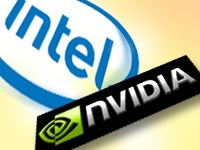 |
For 15 years, Nvidia has quietly grown from a maker of chips for
videogame players into a significant presence among semiconductor makers. And the company has gained high profit margins unburdened with the huge capital expense of high volume manufacturing because it’s always contracted out its chip fabrication.
In that time, Nvidia (NASDAQ: NVDA) has grown into a $4 billion company with no debt, and was dubbed 2007 Company of the Year by Forbes magazine. It owns around two thirds of the discrete graphics market and most of the high end market. The company is as popular with gamers as Wall Street.
So why would it go spoiling for a fight with Intel? Well, maybe it’s not, maybe it’s just defending
its territory. Intel (NASDAQ: INTC) has been making increasing noise about
its upcoming graphics processors on the one hand, while on the other
declaring the graphics processing unit (GPU), that’s Nvidia’s bread-and-butter, all but dead.
Before the recent Intel Developer Conference (IDF) in Shanghai, Intel was all about Larrabee, a forthcoming graphics chip design. At IDF, senior vice president Pat Gelsinger declared the end of graphics as we know it.
“First, graphics that we have all come to know and love today, I have
news for you. It’s coming to an end. Our multi-decade old 3D graphics
rendering architecture that’s based on a rasterization approach is no longer scaleable and suitable for the demands of the future. And we can do much better,” he said, in part.
Jon Peddie, president of Jon Peddie Research and a long-time graphics
industry analyst, first thought the quote was out of context because he
couldn’t believe Gelsinger actually thought Intel had a better graphics offering than a vendor like Nvidia.
“Just that statement by itself is
approaching absurdity. Pat Gelsinger knows graphics as well as anyone in the world. He used to run Intel’s graphics unit. He wouldn’t make a ridiculous statement like that,” he told InternetNews.com.
But the Intel transcript
shows Gelsinger did make the statement in context. Intel was asked to comment on Huang’s statements yesterday or clarify Gelsinger’s comments but repeatedly declined InternetNews.com‘s requests.
Peddie suspects Intel has gotten a little too enthusiastic about its
upcoming graphics projects, and in response, Huang was defending his turf.
The two companies may snipe at each other and steal a little business here
and there, but in the end one needs other. They are yin and yang, Lennon and McCartney, Page and Plant.
“Nvidia isn’t challenged technologically, that’s no contest,” said
Peddie. “They are challenged in a propaganda war. Neither will kill or
obsolete the other, which is why those comments were so absurd. It serves no purpose but to stir things up. The two are totally symbiotic and cannot live without each other.”
In addition to Larrabee, Intel is also rumored to be working on a CPU-GPU combination similar to AMD’s “Fusion” project, but perhaps not quite as ambitious. Huang asserted that it doesn’t matter if you put it in the CPU or outside, it’s still the same old weak GPU from Intel.
It was during the lunch break that Peddie, one of the few technical
analysts at this show, found out just what Nvidia is up against.
“Even after he made all those comments, there were still people saying to
me ‘Well, won’t Intel do better with the GPU in their CPU?’ That’s the
problem Jen-Hsun is trying to counter. When Intel says something it carries
so much weight and it becomes hard to undo,” he said.


